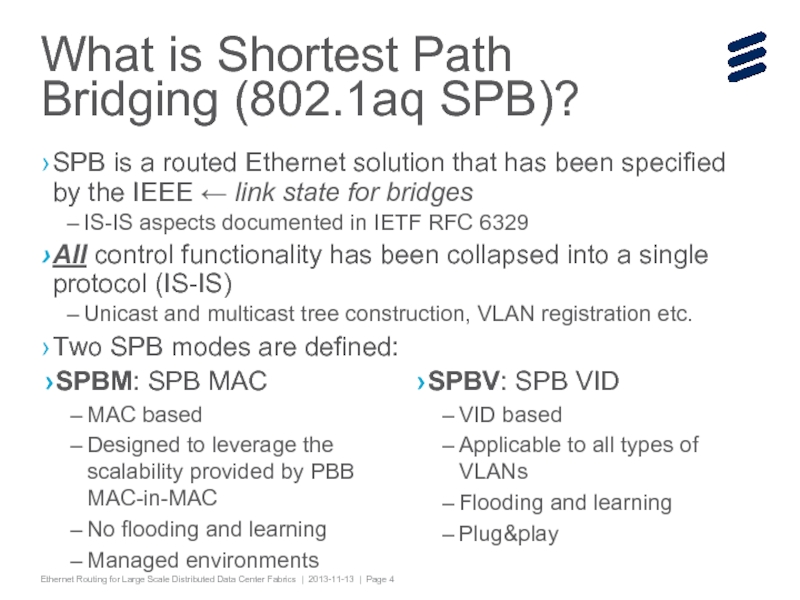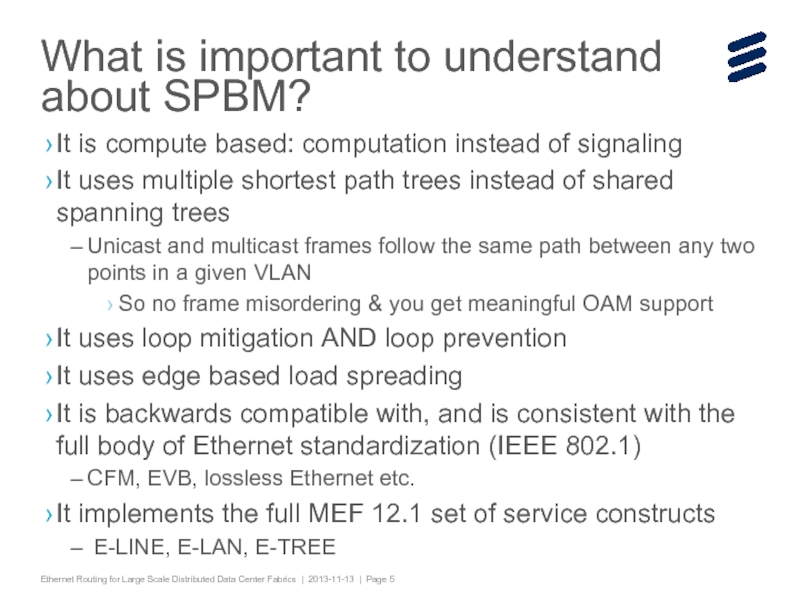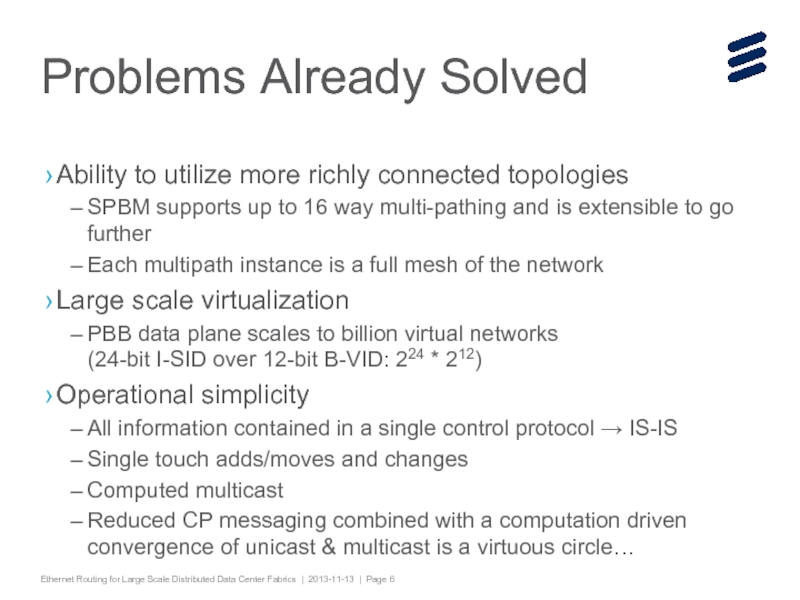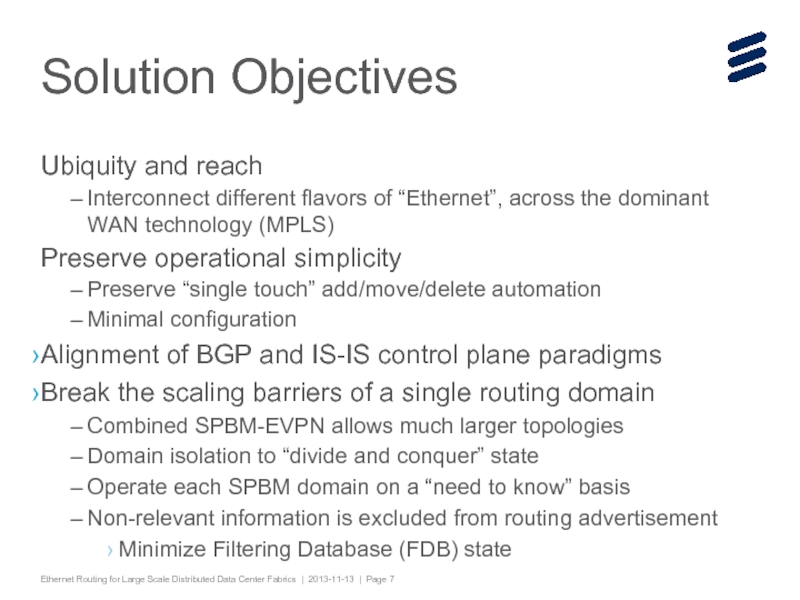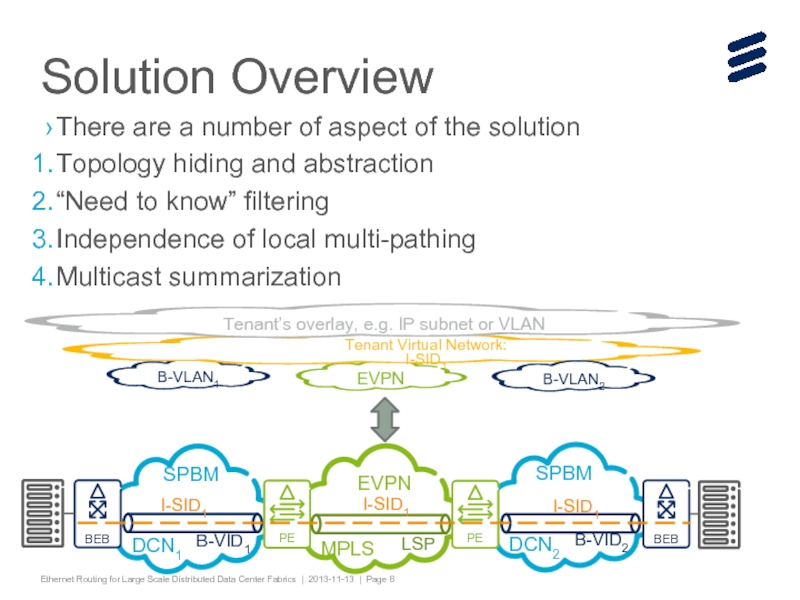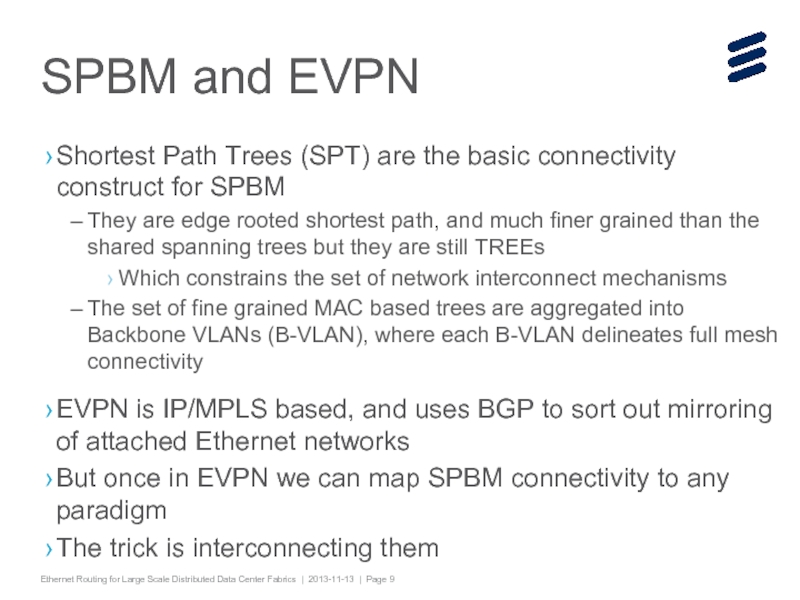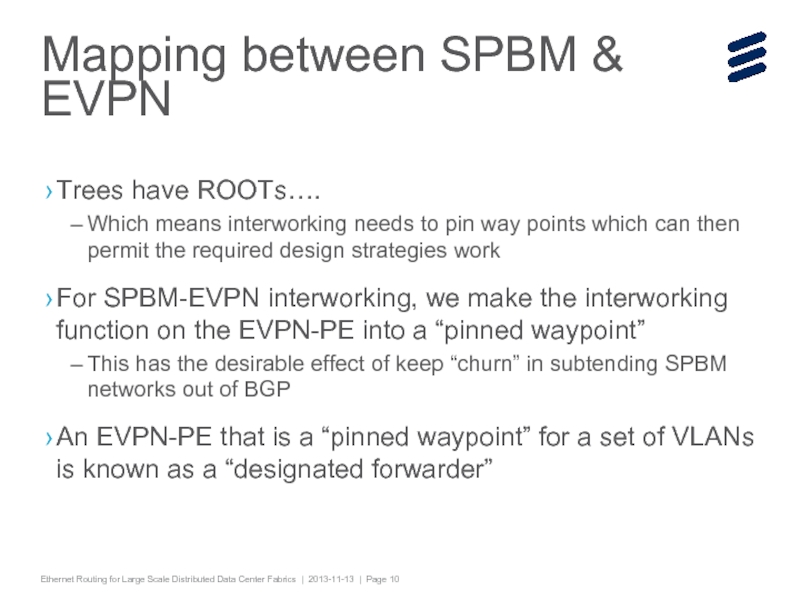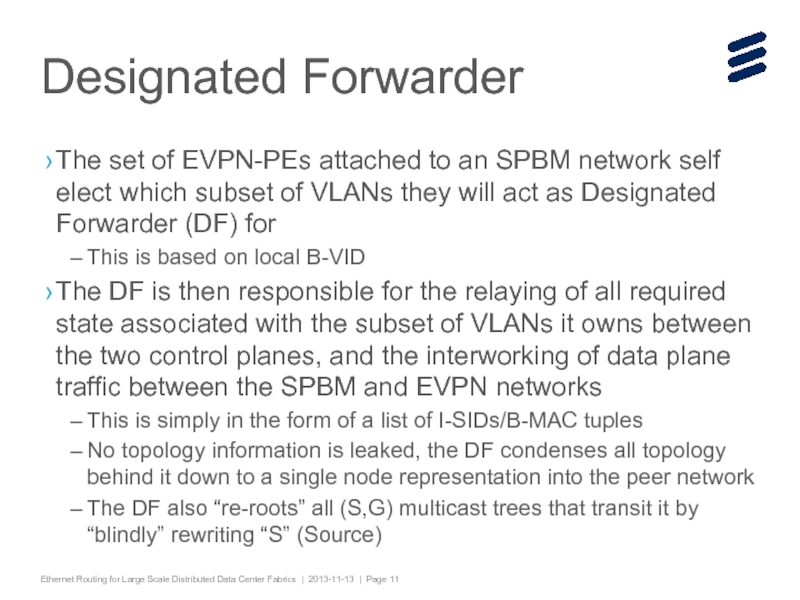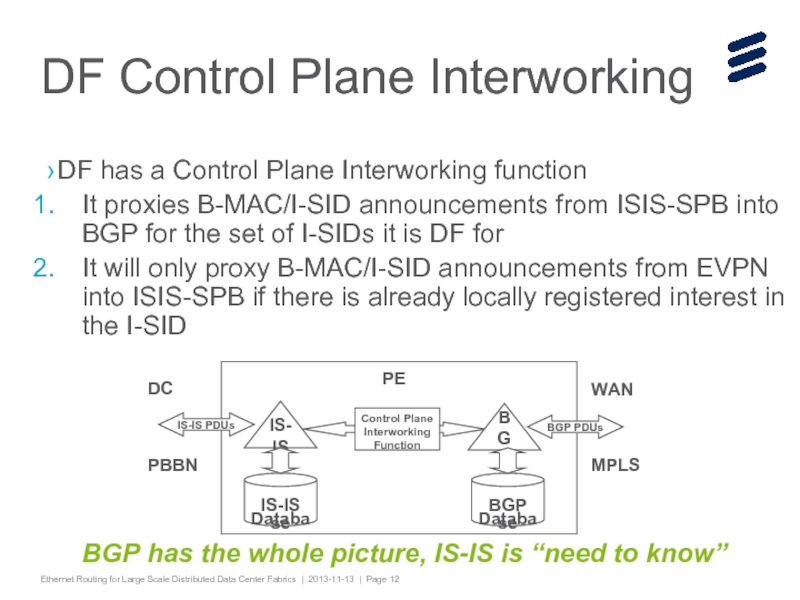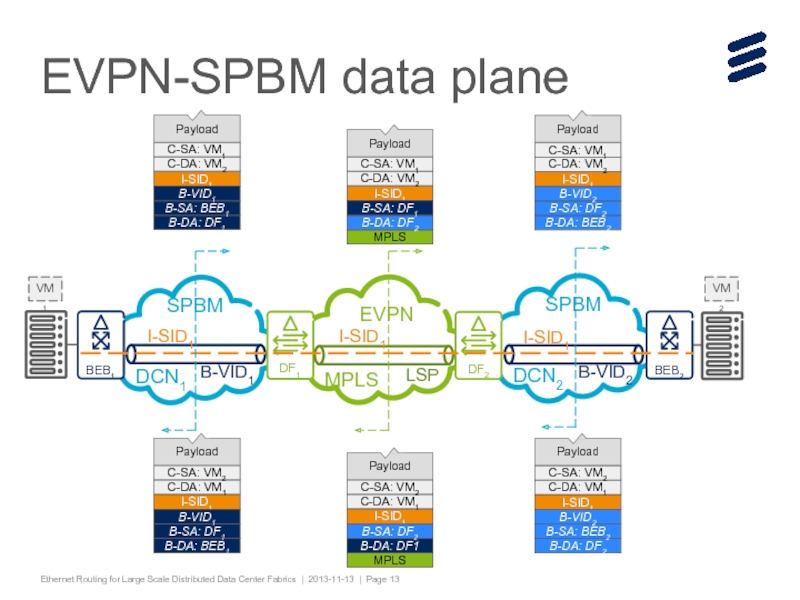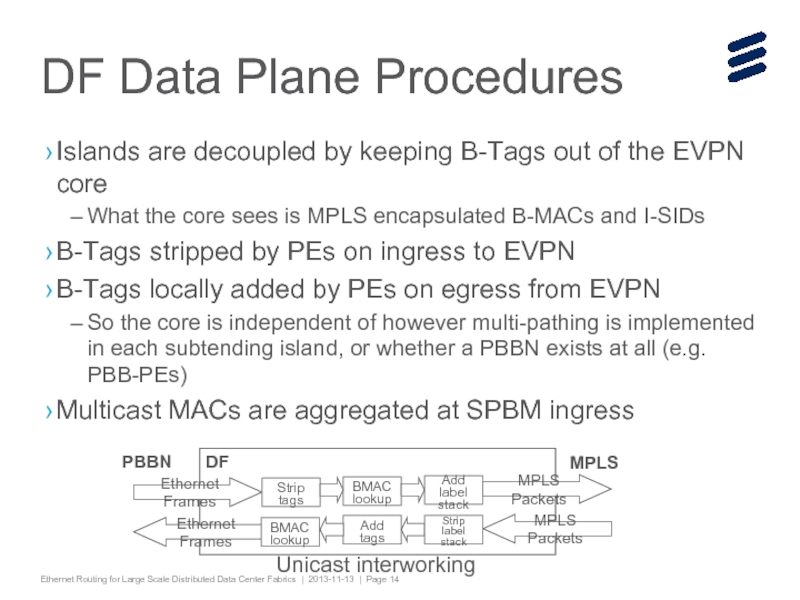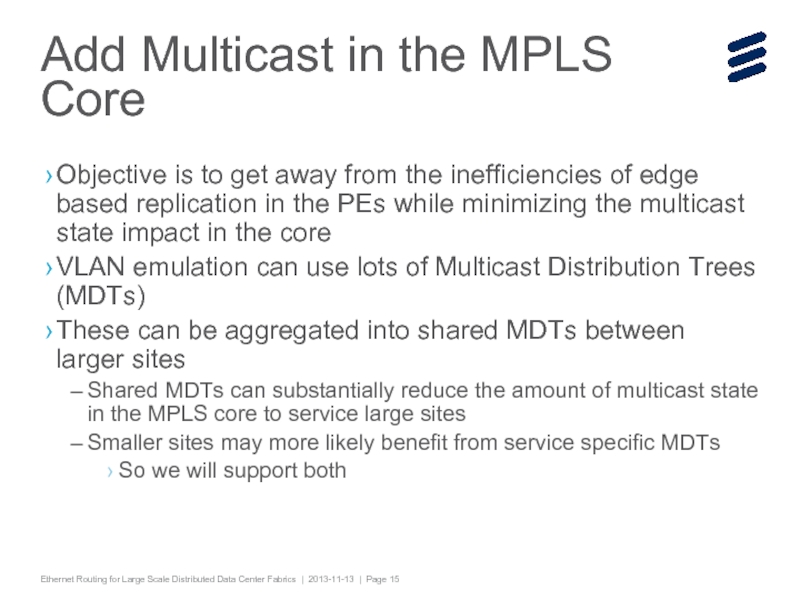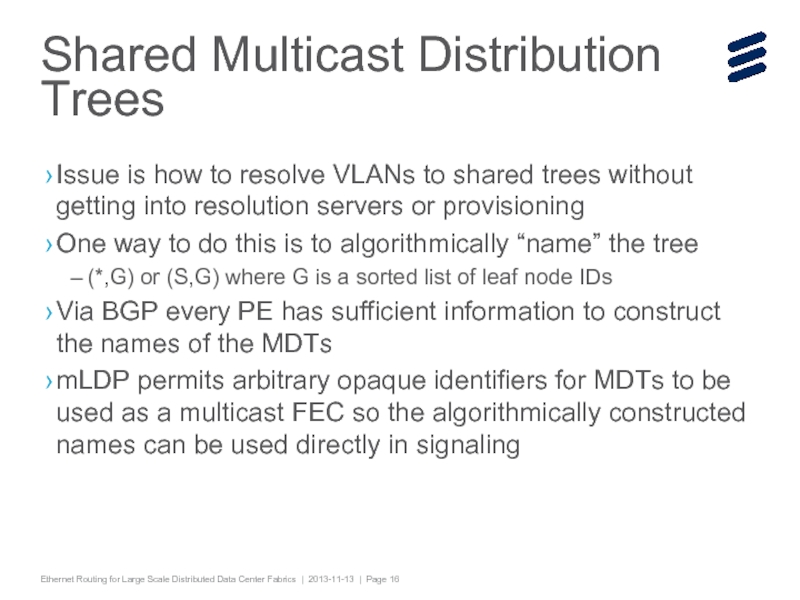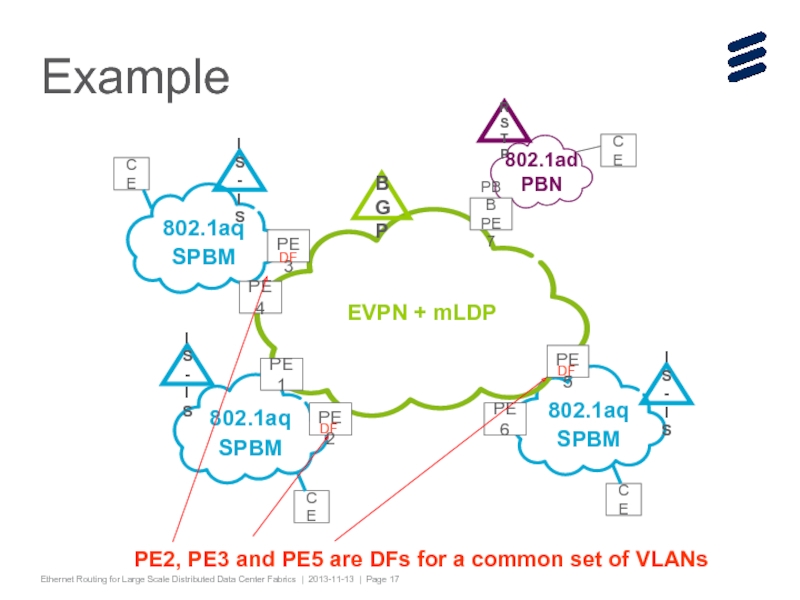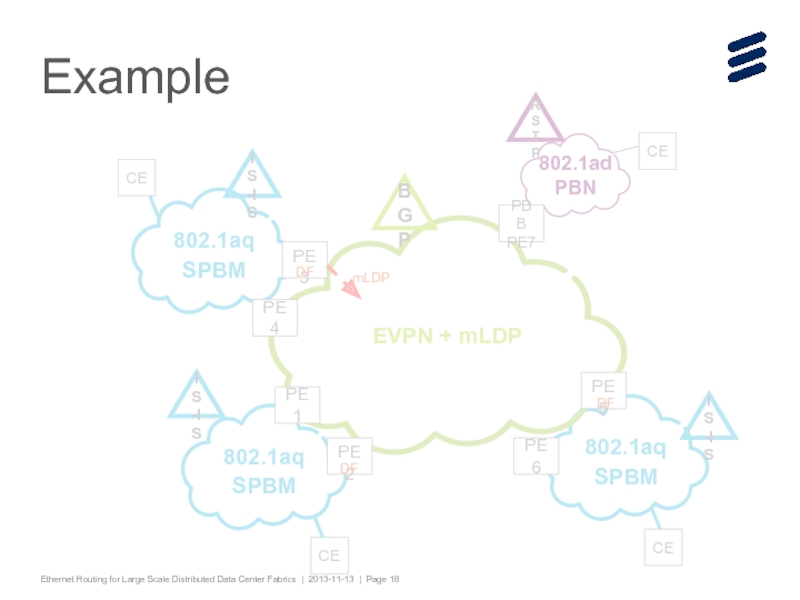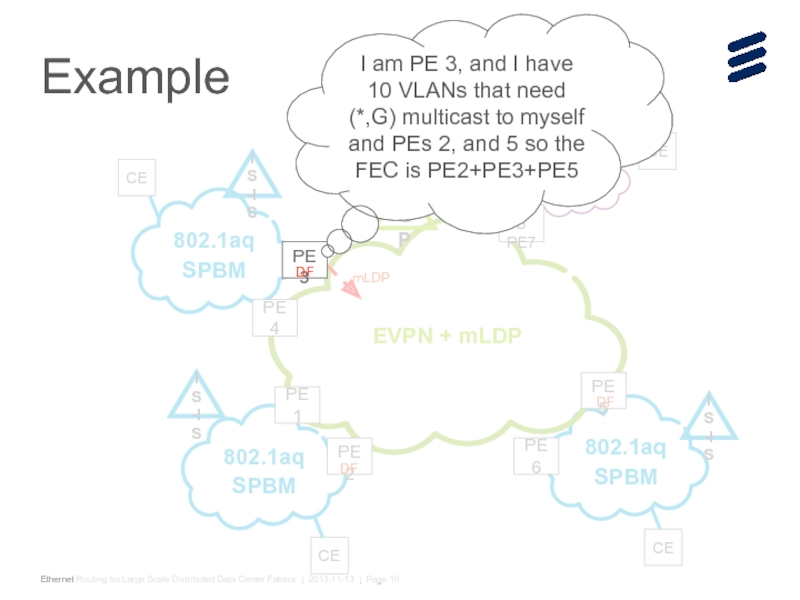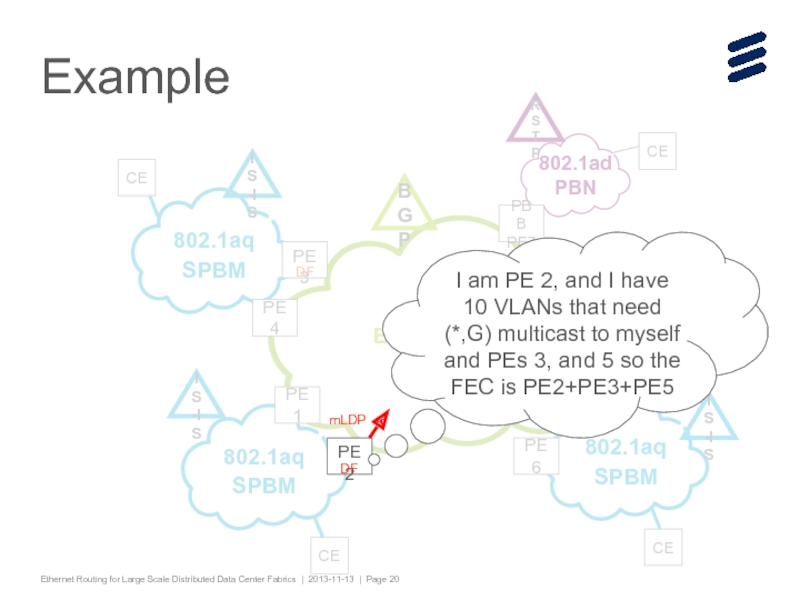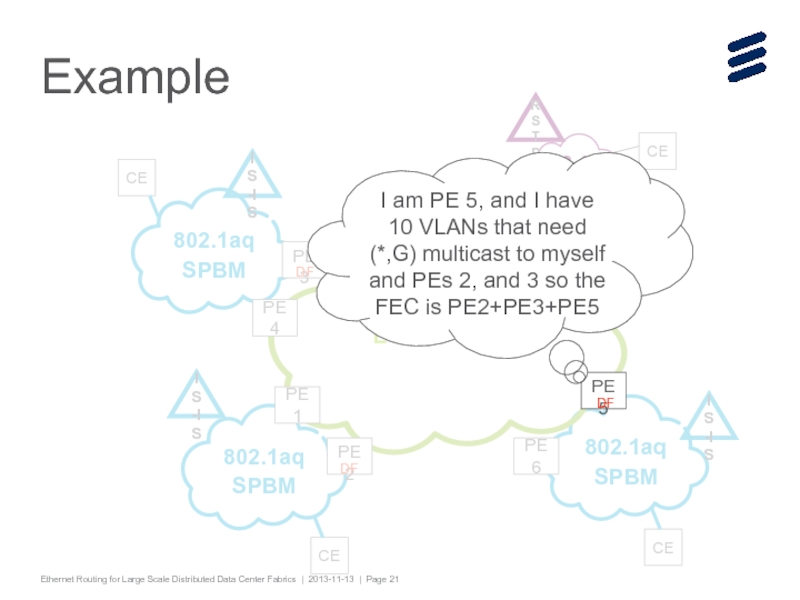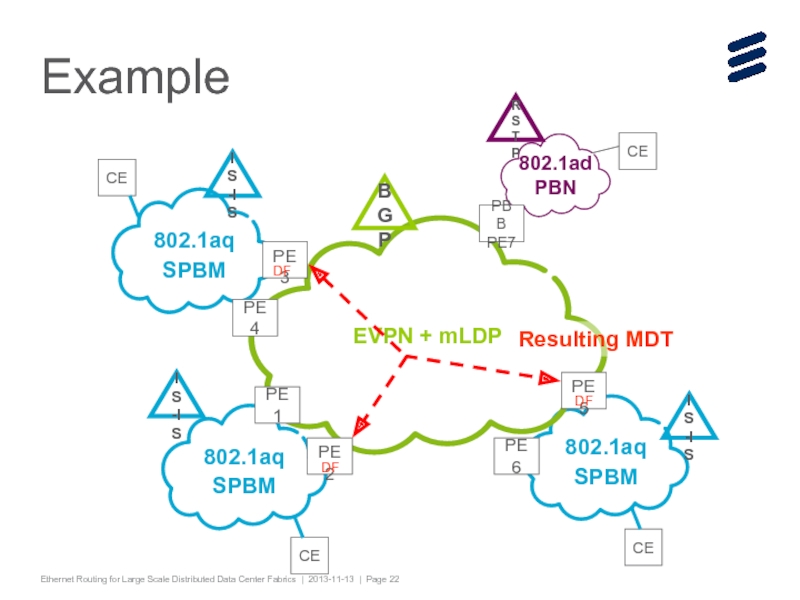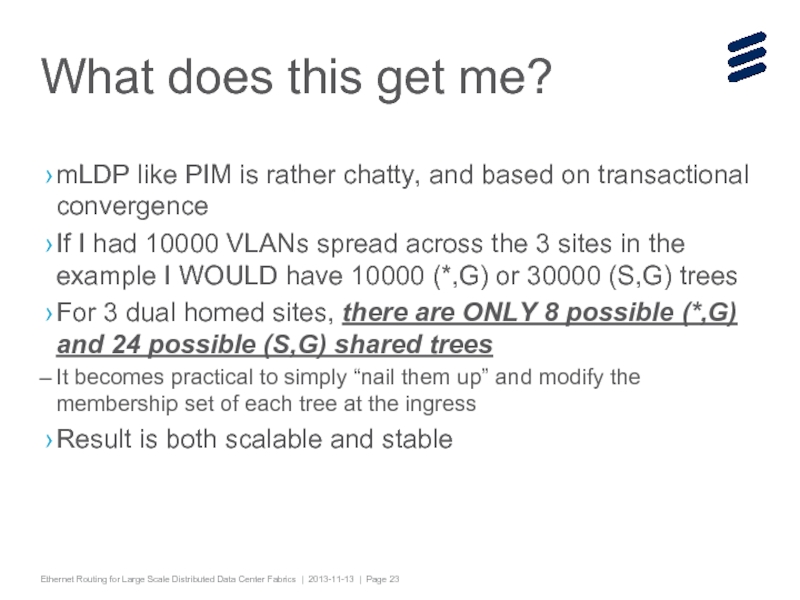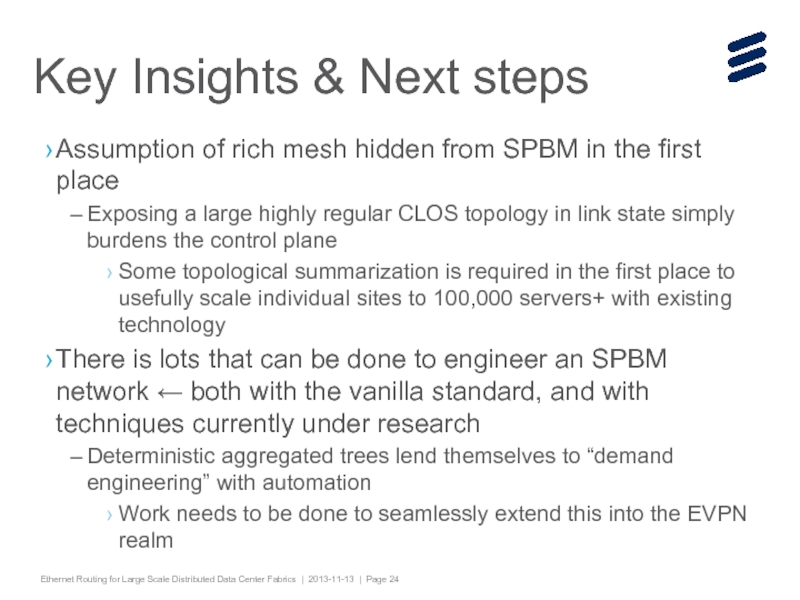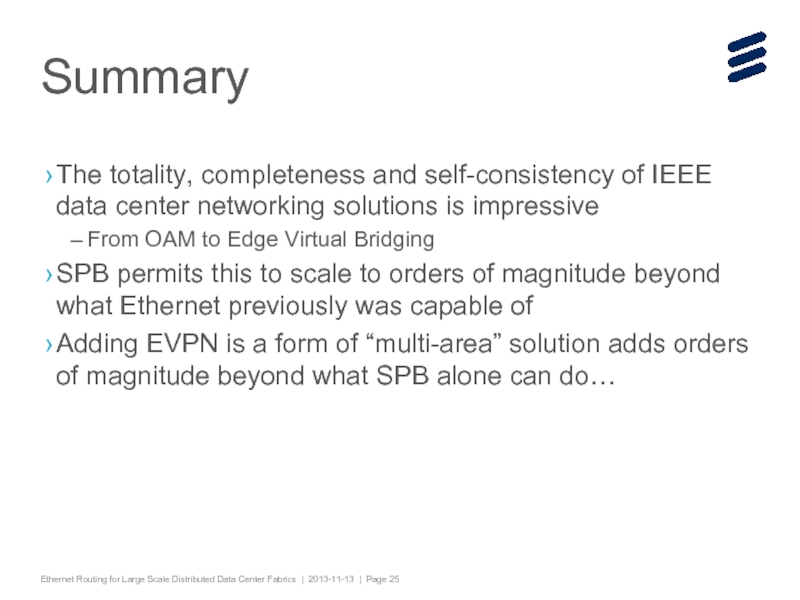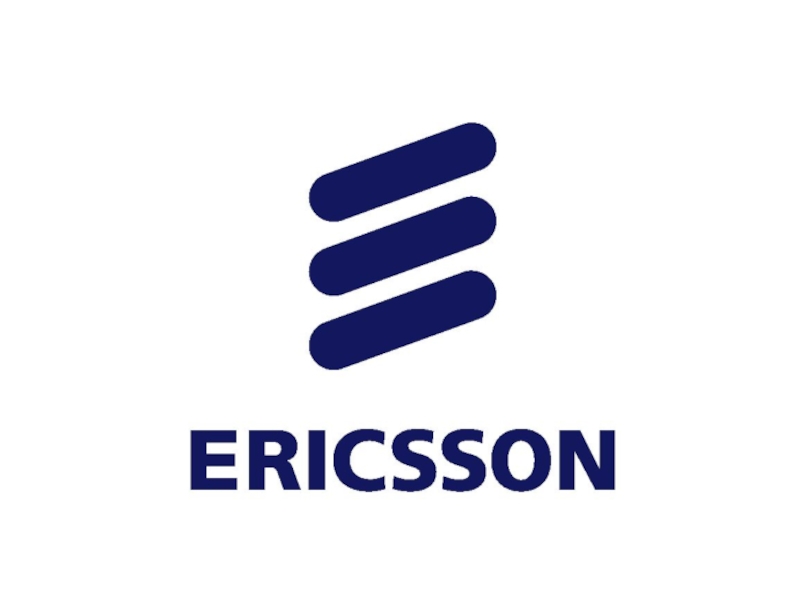- Главная
- Разное
- Дизайн
- Бизнес и предпринимательство
- Аналитика
- Образование
- Развлечения
- Красота и здоровье
- Финансы
- Государство
- Путешествия
- Спорт
- Недвижимость
- Армия
- Графика
- Культурология
- Еда и кулинария
- Лингвистика
- Английский язык
- Астрономия
- Алгебра
- Биология
- География
- Детские презентации
- Информатика
- История
- Литература
- Маркетинг
- Математика
- Медицина
- Менеджмент
- Музыка
- МХК
- Немецкий язык
- ОБЖ
- Обществознание
- Окружающий мир
- Педагогика
- Русский язык
- Технология
- Физика
- Философия
- Химия
- Шаблоны, картинки для презентаций
- Экология
- Экономика
- Юриспруденция
Ethernet Routing for Large Scale DistributedData Center Fabrics презентация
Содержание
- 1. Ethernet Routing for Large Scale DistributedData Center Fabrics
- 2. This is a concept and architecture for
- 3. Key antecedents to SPB Provider Backbone
- 4. SPBV: SPB VID VID based Applicable to
- 5. It is compute based: computation instead of
- 6. Ability to utilize more richly connected topologies
- 7. Ubiquity and reach Interconnect different flavors of
- 8. There are a number of aspect of
- 9. Shortest Path Trees (SPT) are the basic
- 10. Trees have ROOTs…. Which means interworking
- 11. The set of EVPN-PEs attached to an
- 12. DF Control Plane Interworking DF has a
- 13. EVPN-SPBM data plane DCN1 DCN2
- 14. Islands are decoupled by keeping B-Tags out
- 15. Objective is to get away from the
- 16. Issue is how to resolve VLANs to
- 17. Example 802.1aq SPBM 802.1aq SPBM
- 18. Example 802.1aq SPBM 802.1aq SPBM
- 19. Example 802.1aq SPBM 802.1aq SPBM
- 20. Example 802.1aq SPBM 802.1aq SPBM
- 21. Example 802.1aq SPBM 802.1aq SPBM
- 22. Example 802.1aq SPBM 802.1aq SPBM
- 23. mLDP like PIM is rather chatty, and
- 24. Assumption of rich mesh hidden from SPBM
- 25. The totality, completeness and self-consistency of IEEE
Слайд 1Ethernet Routing for
Large Scale Distributed
Data Center Fabrics
Dave Allan,
János Farkas,
Panagiotis Saltsidis,
Jeff Tantsura
Ericsson
Слайд 2This is a concept and architecture for a distributed Cloud
One purpose
The components of the proposed architecture are progressing in standards, either complete or in progress
The architecture is built on
IEEE Shortest Path Bridging – MAC mode (SPBM)
As standardized in IEEE 802.1aq-2012
IETF Ethernet Virtual Private Network (EVPN) as extended for SPBM interworking
This is being standardized in draft-ietf-l2vpn-spbm-evp
Introduction
Слайд 3Key antecedents
to SPB
Provider Backbone
Bridges (PBB)
[802.1ah]
Full MAC-in-MAC encapsulation
24-bit I-SID, which is
PBB Traffic Engineering (PBB-TE) [802.1Qay]
Enabled external control of bridge forwarding with complete route freedom, i.e.
Software Defined Networking (SDN) with geographical separation
A Bit of History
Слайд 4SPBV: SPB VID
VID based
Applicable to all types of VLANs
Flooding and learning
Plug&play
SPBM:
MAC based
Designed to leverage the scalability provided by PBB MAC-in-MAC
No flooding and learning
Managed environments
What is Shortest Path Bridging (802.1aq SPB)?
SPB is a routed Ethernet solution that has been specified by the IEEE ← link state for bridges
IS-IS aspects documented in IETF RFC 6329
All control functionality has been collapsed into a single protocol (IS-IS)
Unicast and multicast tree construction, VLAN registration etc.
Two SPB modes are defined:
Слайд 5It is compute based: computation instead of signaling
It uses multiple shortest
Unicast and multicast frames follow the same path between any two points in a given VLAN
So no frame misordering & you get meaningful OAM support
It uses loop mitigation AND loop prevention
It uses edge based load spreading
It is backwards compatible with, and is consistent with the full body of Ethernet standardization (IEEE 802.1)
CFM, EVB, lossless Ethernet etc.
It implements the full MEF 12.1 set of service constructs
E-LINE, E-LAN, E-TREE
What is important to understand about SPBM?
Слайд 6Ability to utilize more richly connected topologies
SPBM supports up to 16
Each multipath instance is a full mesh of the network
Large scale virtualization
PBB data plane scales to billion virtual networks (24-bit I-SID over 12-bit B-VID: 224 * 212)
Operational simplicity
All information contained in a single control protocol → IS-IS
Single touch adds/moves and changes
Computed multicast
Reduced CP messaging combined with a computation driven convergence of unicast & multicast is a virtuous circle…
Problems Already Solved
Слайд 7Ubiquity and reach
Interconnect different flavors of “Ethernet”, across the dominant WAN
Preserve operational simplicity
Preserve “single touch” add/move/delete automation
Minimal configuration
Alignment of BGP and IS-IS control plane paradigms
Break the scaling barriers of a single routing domain
Combined SPBM-EVPN allows much larger topologies
Domain isolation to “divide and conquer” state
Operate each SPBM domain on a “need to know” basis
Non-relevant information is excluded from routing advertisement
Minimize Filtering Database (FDB) state
Solution Objectives
Слайд 8There are a number of aspect of the solution
Topology hiding
“Need to know” filtering
Independence of local multi-pathing
Multicast summarization
Solution Overview
DCN1
EVPN
DCN2
MPLS
B-VID1
I-SID1
LSP
I-SID1
I-SID1
B-VID2
SPBM
SPBM
EVPN
Слайд 9Shortest Path Trees (SPT) are the basic connectivity construct for SPBM
They are edge rooted shortest path, and much finer grained than the shared spanning trees but they are still TREEs
Which constrains the set of network interconnect mechanisms
The set of fine grained MAC based trees are aggregated into Backbone VLANs (B-VLAN), where each B-VLAN delineates full mesh connectivity
EVPN is IP/MPLS based, and uses BGP to sort out mirroring of attached Ethernet networks
But once in EVPN we can map SPBM connectivity to any paradigm
The trick is interconnecting them
SPBM and EVPN
Слайд 10
Trees have ROOTs….
Which means interworking needs to pin way points which
For SPBM-EVPN interworking, we make the interworking function on the EVPN-PE into a “pinned waypoint”
This has the desirable effect of keep “churn” in subtending SPBM networks out of BGP
An EVPN-PE that is a “pinned waypoint” for a set of VLANs is known as a “designated forwarder”
Mapping between SPBM & EVPN
Слайд 11The set of EVPN-PEs attached to an SPBM network self elect
This is based on local B-VID
The DF is then responsible for the relaying of all required state associated with the subset of VLANs it owns between the two control planes, and the interworking of data plane traffic between the SPBM and EVPN networks
This is simply in the form of a list of I-SIDs/B-MAC tuples
No topology information is leaked, the DF condenses all topology behind it down to a single node representation into the peer network
The DF also “re-roots” all (S,G) multicast trees that transit it by “blindly” rewriting “S” (Source)
Designated Forwarder
Слайд 12DF Control Plane Interworking
DF has a Control Plane Interworking function
It proxies
It will only proxy B-MAC/I-SID announcements from EVPN into ISIS-SPB if there is already locally registered interest in the I-SID
BGP has the whole picture, IS-IS is “need to know”
Слайд 14Islands are decoupled by keeping B-Tags out of the EVPN core
What
B-Tags stripped by PEs on ingress to EVPN
B-Tags locally added by PEs on egress from EVPN
So the core is independent of however multi-pathing is implemented in each subtending island, or whether a PBBN exists at all (e.g. PBB-PEs)
Multicast MACs are aggregated at SPBM ingress
DF Data Plane Procedures
Слайд 15Objective is to get away from the inefficiencies of edge based
VLAN emulation can use lots of Multicast Distribution Trees (MDTs)
These can be aggregated into shared MDTs between larger sites
Shared MDTs can substantially reduce the amount of multicast state in the MPLS core to service large sites
Smaller sites may more likely benefit from service specific MDTs
So we will support both
Add Multicast in the MPLS Core
Слайд 16Issue is how to resolve VLANs to shared trees without getting
One way to do this is to algorithmically “name” the tree
(*,G) or (S,G) where G is a sorted list of leaf node IDs
Via BGP every PE has sufficient information to construct the names of the MDTs
mLDP permits arbitrary opaque identifiers for MDTs to be used as a multicast FEC so the algorithmically constructed names can be used directly in signaling
Shared Multicast Distribution Trees
Слайд 17Example
802.1aq
SPBM
802.1aq
SPBM
802.1ad PBN
802.1aq
SPBM
EVPN + mLDP
PE1
PE2
PE6
PE5
PE3
PE4
PBB
PE7
BGP
IS-IS
CE
CE
CE
CE
RSTP
IS-IS
IS-IS
DF
DF
DF
PE2, PE3 and PE5 are
Слайд 18Example
802.1aq
SPBM
802.1aq
SPBM
802.1ad PBN
802.1aq
SPBM
EVPN + mLDP
PE1
PE6
PE5
PE4
PBB
PE7
BGP
IS-IS
CE
CE
CE
CE
RSTP
IS-IS
IS-IS
DF
PE2
DF
PE3
DF
mLDP
Слайд 19Example
802.1aq
SPBM
802.1aq
SPBM
802.1ad PBN
802.1aq
SPBM
EVPN + mLDP
PE1
PE6
PE5
PE4
PBB
PE7
BGP
IS-IS
CE
CE
CE
CE
RSTP
IS-IS
IS-IS
DF
PE2
DF
mLDP
PE3
DF
I am PE 3, and
Слайд 20Example
802.1aq
SPBM
802.1aq
SPBM
802.1ad PBN
802.1aq
SPBM
EVPN + mLDP
PE1
PE6
PE5
PE4
PBB
PE7
BGP
IS-IS
CE
CE
CE
CE
RSTP
IS-IS
IS-IS
DF
PE3
DF
PE2
DF
mLDP
I am PE 2, and
Слайд 21Example
802.1aq
SPBM
802.1aq
SPBM
802.1ad PBN
802.1aq
SPBM
EVPN + mLDP
PE1
PE6
PE4
PBB
PE7
BGP
IS-IS
CE
CE
CE
CE
RSTP
IS-IS
IS-IS
PE2
DF
PE3
DF
PE5
DF
I am PE 5, and
Слайд 22Example
802.1aq
SPBM
802.1aq
SPBM
802.1ad PBN
802.1aq
SPBM
EVPN + mLDP
PE1
PE6
PE4
PBB
PE7
BGP
IS-IS
CE
CE
CE
CE
RSTP
IS-IS
IS-IS
PE3
DF
PE2
DF
PE5
DF
Resulting MDT
Слайд 23mLDP like PIM is rather chatty, and based on transactional convergence
If
For 3 dual homed sites, there are ONLY 8 possible (*,G) and 24 possible (S,G) shared trees
It becomes practical to simply “nail them up” and modify the membership set of each tree at the ingress
Result is both scalable and stable
What does this get me?
Слайд 24Assumption of rich mesh hidden from SPBM in the first place
Exposing
Some topological summarization is required in the first place to usefully scale individual sites to 100,000 servers+ with existing technology
There is lots that can be done to engineer an SPBM network ← both with the vanilla standard, and with techniques currently under research
Deterministic aggregated trees lend themselves to “demand engineering” with automation
Work needs to be done to seamlessly extend this into the EVPN realm
Key Insights & Next steps
Слайд 25The totality, completeness and self-consistency of IEEE data center networking solutions
From OAM to Edge Virtual Bridging
SPB permits this to scale to orders of magnitude beyond what Ethernet previously was capable of
Adding EVPN is a form of “multi-area” solution adds orders of magnitude beyond what SPB alone can do…
Summary
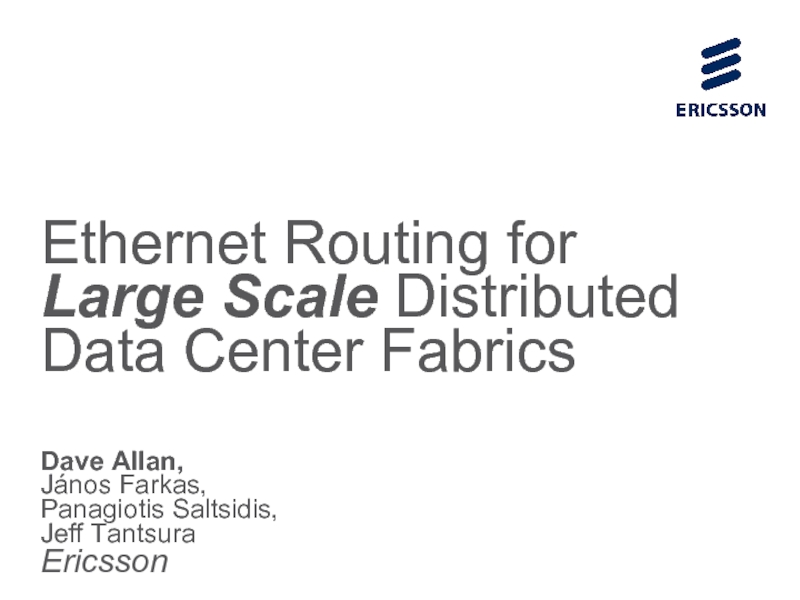
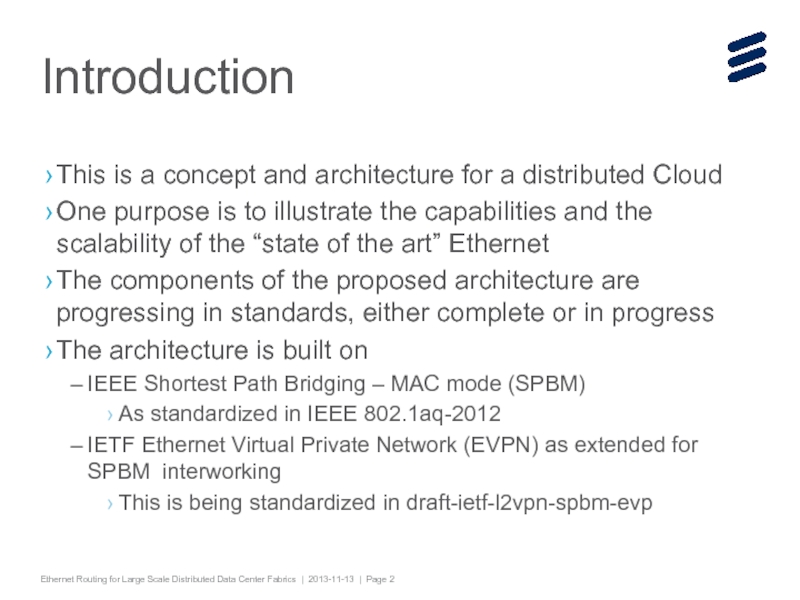
![Key antecedents to SPBProvider Backbone Bridges (PBB) [802.1ah]Full MAC-in-MAC encapsulation24-bit I-SID, which is a 24-bit](/img/tmb/1/26082/7b3ac45bd9eddbe8f2b3ab14b8d2a342-800x.jpg)
